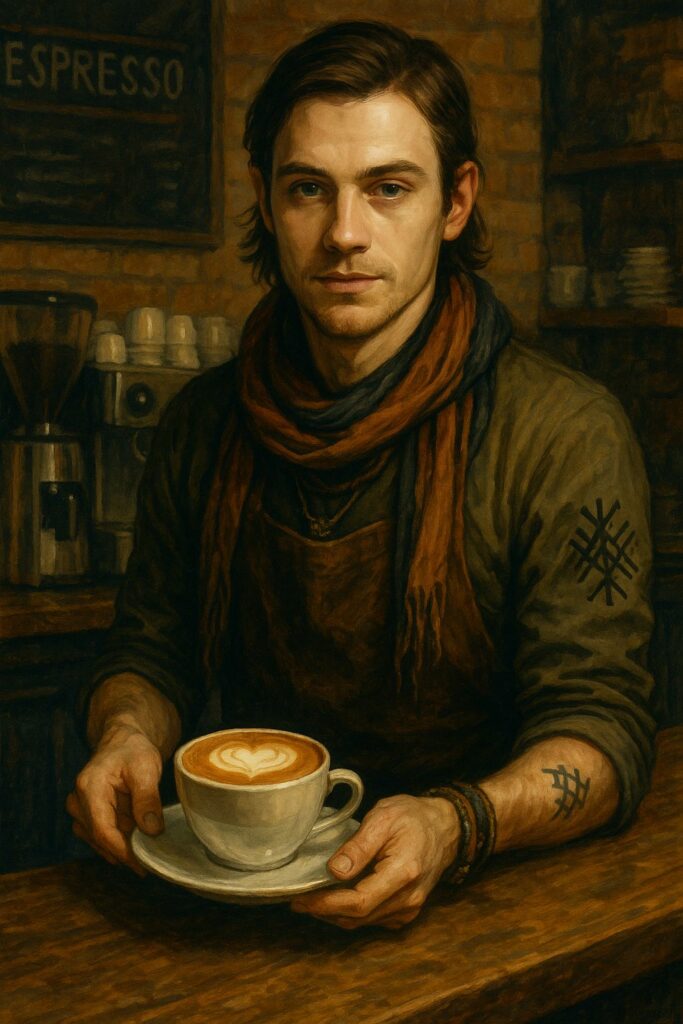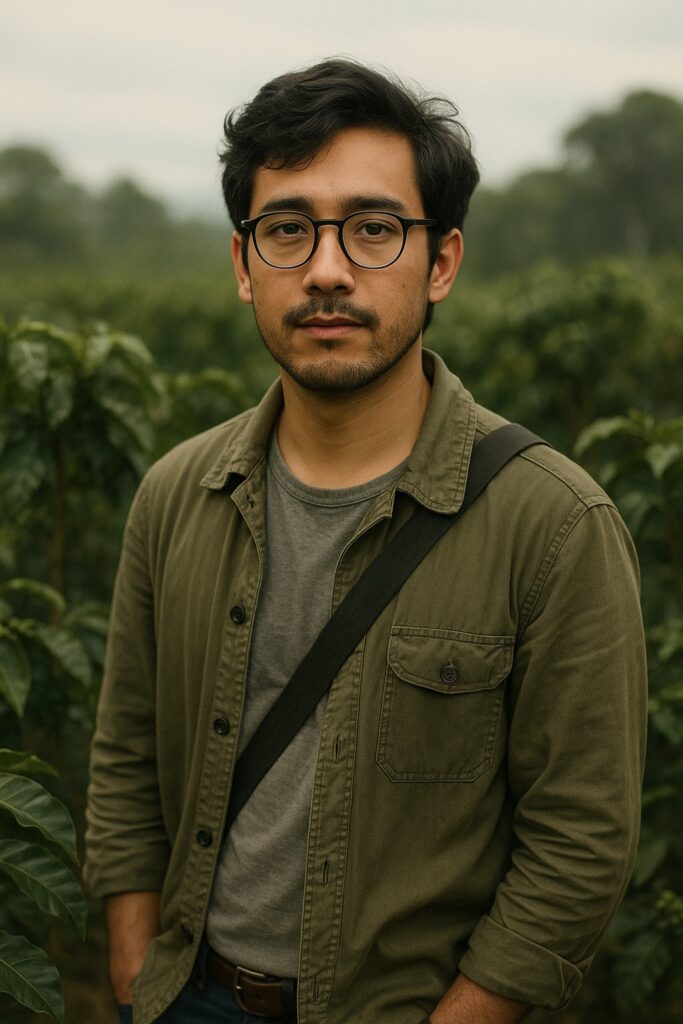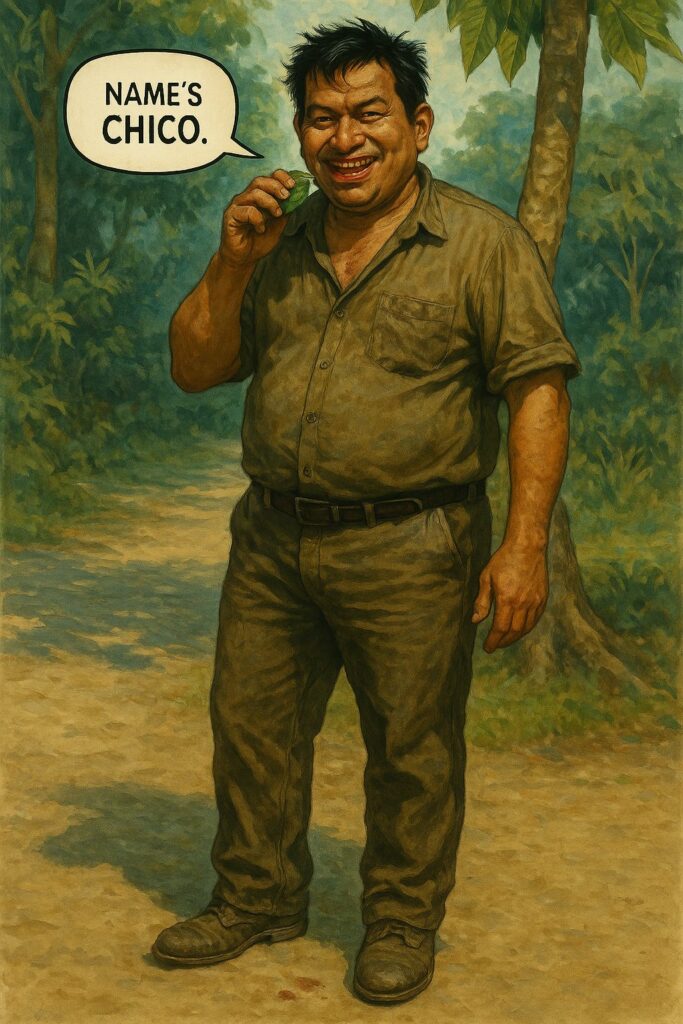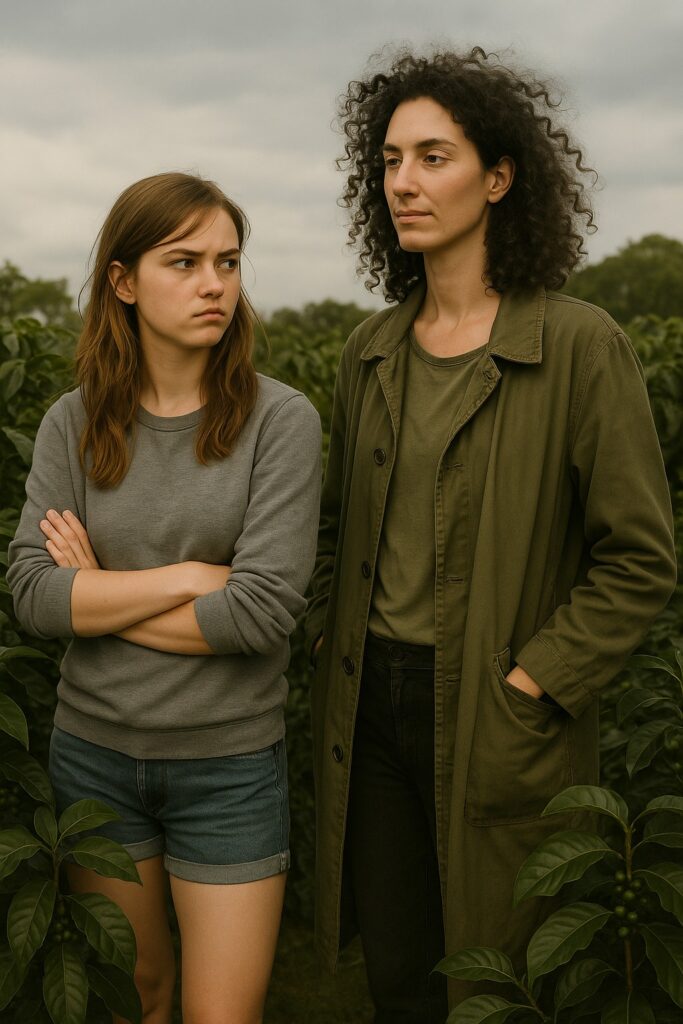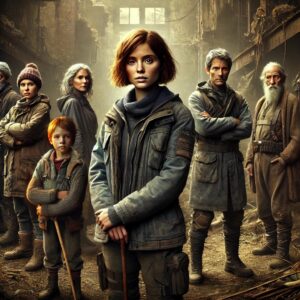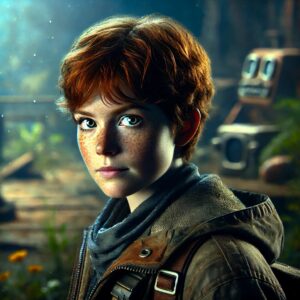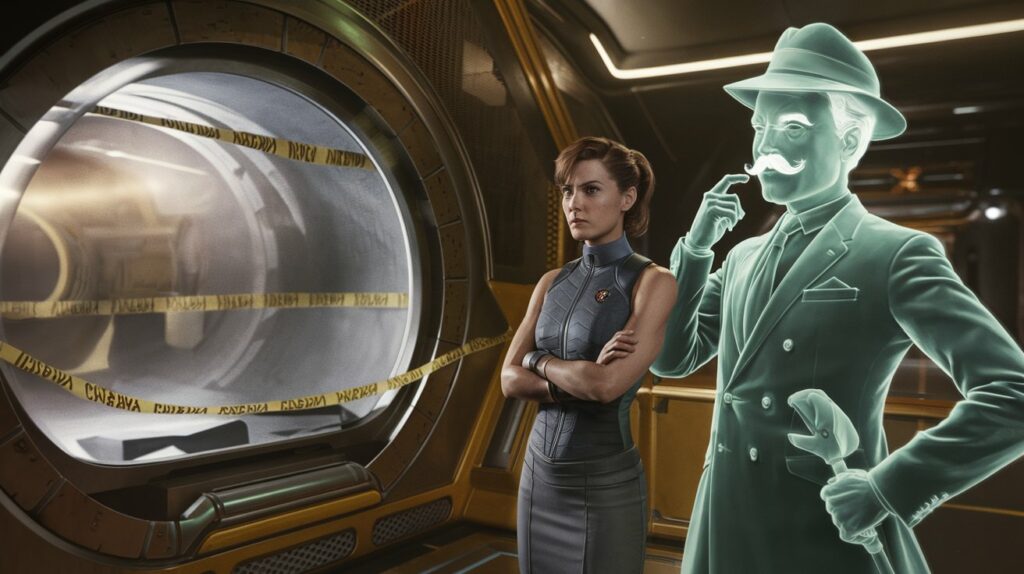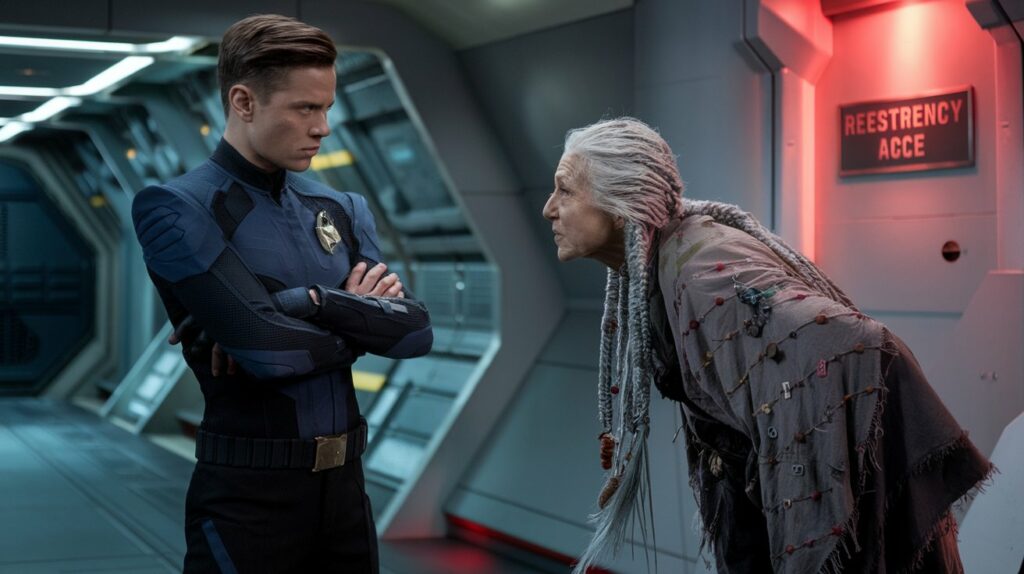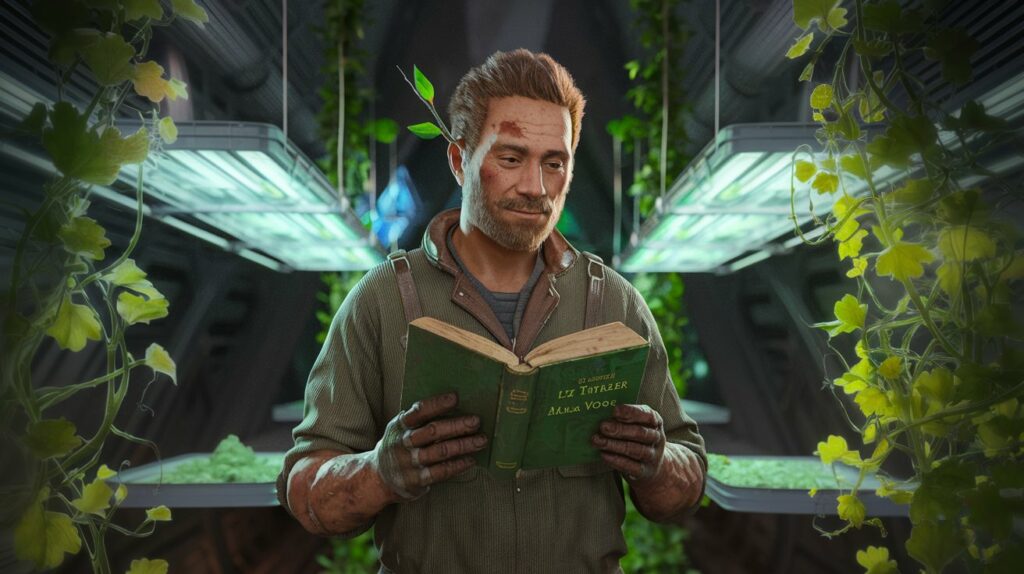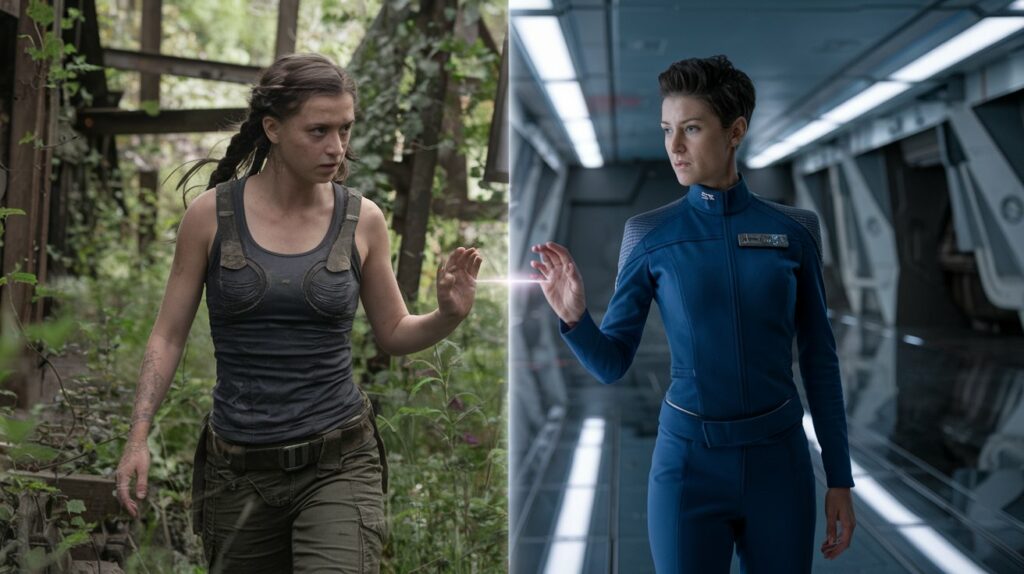Forum Replies Created
-
AuthorReplies
-
Enter Liz’s Tipsy Waltz
[Verse]
Feathered quill meets parchment skin
Elizabeth writes where scandals begin
Pink champagne spills on the floor
Cougar’s grin says she’s ready for more[Verse 2]
Famed author weaves sly tales with fire
Slutty thoughts fuel Roberto’s desire
Finnley
The ghost
Hides in the night
Typewriter clicks
Dim candlelight[Chorus]
Ink and lust flow through this tale
Secrets whispered on parchment pale
Godfrey nuts
Edits the scene
In this wild world
What’s it all mean?[Verse 3]
In the cabinet where whispers creak
Roberto shows a sly technique
Finnley sighs
Unseen but clear
Through the shadows
His words appear[Bridge]
Elizabeth leads with a champagne toast
A cougar’s smirk
The fading ghost
Peanuts scatter
Chaos remains
A writer’s world drips ink and stains[Verse 4]
Pages flutter
They dance
They shout
Godfrey snickers
Edits play out
Roberto winks with knowing grace
In this madhouse
Who sets the pace? The Cofficionados Theme Song “Dont Trust a Goat with a Plan”
The Cofficionados Theme Song “Dont Trust a Goat with a Plan”[Verse]
Goat in a bow tie whispers
“Trust me
My dear”
A plan in its hooves but intentions unclear
Guard the coffee belt like a treasure map’s end
Four bandits are plotting to twist and upend[Chorus]
Don’t trust a goat with a plan
My friend
They’ll sip your dreams while you defend
Lucid nights sabotaged mid-spin
By cofficionados sneaking in[Verse 2]
Carob in shadows
No cocoa in sight
Thiram with whispers that steal your midnight
Amy’s sweet smile hides beans of deceit
Chico grinds chaos
The bitter elite[Bridge]
Sleep-parachute breaches
Reverse dreams collide
They’ve hijacked your pillow for the wildest ride
Beware the saboteurs that seep in deep
Between dripping espresso and REM sleep[Chorus]
Don’t trust a goat with a plan
My friend
They’ll sip your dreams while you defend
Lucid nights sabotaged mid-spin
By cofficionados sneaking in[Verse 3]
Pour your resistance in a steaming haze
Shield the roast aroma from their forking ways
The bandits want dominion over your grind
But you’ll wake alert with their schemes left behindGodric
⚫ Godric
What We Know Visually:
-
Identified as Swedish, possibly tall and pale by stereotype.
-
A barista-channeler, so likely has the look of a mystical hipster.
Inferred Presence/Style:
-
May wear layered scarves, bracelets with charms, or ceremonial aprons.
-
The term Draugaskalds connects him to Norse aesthetics—he might carry old symbols or tattoos.
Unclear:
-
Concrete outfit, facial expression, or posture.
-
Age and physical habits.
Thiram Izu
Thiram Izu – The Bookish Tinkerer with Tired Eyes
Explicit Description
-
Age: Mid-30s
-
Heritage: Half-Japanese, half-Colombian
-
Face: Calm but slightly worn—reflecting quiet resilience and perceptiveness.
-
Hair: Short, tousled dark hair
-
Eyes: Observant, introspective; wears round black-framed glasses
-
Clothing (standard look):
-
Olive-green utilitarian overshirt or field jacket
-
Neutral-toned T-shirt beneath
-
Crossbody strap (for a toolkit or device bag)
-
Simple belt, jeans—functional, not stylish
-
-
Technology: Regularly uses a homemade device, possibly a patchwork blend of analog and AI circuitry.
-
Name Association: Jokes about being named after a fungicide (Thiram), referencing “brothers” Malathion and Glyphosate.
Inferred Personality & Manner
-
Temperament: Steady but simmering—he tries to be the voice of reason, but often ends up exasperated or ignored.
-
Mindset: Driven by a need for internal logic and external systems—he’s a fixer, not a dreamer (yet paradoxically surrounded by dreamers).
-
Social Role: The least performative of the group. He’s neither aloof nor flamboyant, but remains essential—a grounded presence.
-
Habits:
-
Zones out under stress or when overstimulated by dream-logic.
-
Blinks repeatedly to test for lucid dream states.
-
Carries small parts or tools in pockets—likely fidgets with springs or wires during conversations.
-
-
Dialogue Style: Deadpan, dry, occasionally mutters tech references or sarcastic analogies.
-
Emotional Core: Possibly a romantic or idealist in denial—hidden under his annoyance and muttered diagnostics.
Function in the Group
-
Navigator of Reality – He’s the one most likely to point out when the laws of physics are breaking… and then sigh and fix it.
-
Connector of Worlds – Bridges raw tech with dream-invasion mechanisms, perhaps more than he realizes.
-
Moral Compass (reluctantly) – Might object to sabotage-for-sabotage’s-sake; he values intent.
Chico Ray
Chico Ray
Directly Stated Visual and Behavioral Details:
-
Introduces himself casually: “Name’s Chico,” with no clear past, suggesting a self-aware or recently-written character.
-
Chews betel leaves, staining his teeth red, which gives him a slightly unsettling or feral appearance.
-
Spits on the floor, even in a freshly cleaned café—suggesting poor manners, or possibly defiance.
-
Appears from behind a trumpet tree, implying he lurks or emerges unpredictably.
-
Fabricates plausible-sounding geo-political nonsense (e.g., the coffee restrictions in Rwanda), then second-guesses whether it was fiction or memory.
Inferred Traits:
-
A sharp smile made more vivid by betel staining.
-
Likely wears earth-toned clothes, possibly tropical—evoking Southeast Asian or Central American flavors.
-
Comes off as a blend of rogue mystic and unreliable narrator, leaning toward surreal trickster.
-
Psychological ambiguity—he doubts his own origins, possibly a hallucination, dream being, or quantum hitchhiker.
What Remains Unclear:
-
Precise age or background.
-
His affiliations or loyalties—he doesn’t seem clearly aligned with the Bandits or Lucid Dreamers, but hovers provocatively at the edges.
Amy & Carob
☕ Amy Kawanhouse
Directly Stated Visual Traits:
-
Hair: Long, light brown
-
Eyes: Hazel, often sweaty or affected by heat/rain
-
Clothing: Old grey sweatshirt with pushed-up sleeves
-
Body: Short and thin, with shapely legs in denim
-
Style impression: Understated and practical, slightly tomboyish, no-frills but with a hint of self-aware physicality
Inferred From Behavior:
-
Functional but stylish in a low-maintenance way.
-
Comfortable with being dirty or goat-adjacent.
-
Probably ties her hair back when annoyed.
☕ Carob Latte
Directly Stated Visual Traits:
-
Height: Tall (Amy refers to her as “looming”)
-
Hair: Frizzled—possibly curly or electrified, chaotic in texture
-
General Look: Disheveled but composed; possibly wears layered or unusual clothing (fitting her dreamy reversal quirks)
Inferred From Behavior:
-
Movements are languid or deliberately unhurried.
-
Likely wears things with big pockets or flowing elements—goat-compatible.
-
There’s an aesthetic at play: eccentric wilderness mystic or mad cartographer.
Key Themes and Narrative Elements
Metafiction & Self-Reference: Characters frequently comment on their own construction, roles, and how being written (or observed) defines their reality. Amy especially embodies this.
Lucid Dreaming & Dream Logic: The boundary between reality and dream is porous. Lucid Dreamers are parachuting onto plantations, and Carob dreams in reverse. Lucid Dreamers are adverse to Coffee Plantations as they keep the World awake.
Coffee as Sacred Commodity: The coffee plantation is central to the story’s stakes. It’s under threat from climate (rain), AI malfunctions, and rogue dreamers. This plays comically on global commodity anxiety.
Technology Satire & AI Sentience: Emotional AI, “Silly Intelligence” devices, and exasperation with modern tech hint at mild technophobia or skepticism. All fueled by hot caffeinated piece of news.
Fictionality vs. Reality: Juan and Dolores embody this—grappling with what it means to be real. Dolores vanishes when no one looks—existence contingent on observation.
Rain & Weather as Mood Symbol: The rain is persistent—setting a tone of gentle absurdity and tension, while also providing plot catalyst.
Arthurian Parallels in Helix 25
This table explores an overlay of Arthurian archetypes woven into the narrative of Helix 25.
By mapping key mythological figures to characters and themes within the story, it provides archetypal templates for exploration of leadership, unity, betrayal, and redemption in a futuristic setting.Arthurian Archetype Role in Arthurian Myth Helix 25 Counterpart Narrative Integration in Helix 25 Themes & Contemporary Reflections Merlin Wise guide, prophet, keeper of lost knowledge, enigmatic mentor. Merdhyn Winstrom Hermit survivor whose beacon reawakens lost knowledge, eccentric guide bridging Earth and Helix. Echoes of lost wisdom resurfacing in times of crisis. Role of eccentric thinkers in shaping the future. King Arthur (Once and Future King) Sleeping leader destined to return, restorer of order and unity. Captain Veranassessee Cryo-sleeping leader awakened to restore stability and uncover ship’s deeper truths. Balancing destiny, responsibility, and the burden of leadership in a fractured world. Lady of the Lake Guardian of sacred wisdom, bestower of power, holds destiny in trust. Molly & Ellis Marlowe Custodians of ancestral knowledge, connecting genetic past to future, deciding who is worthy. Gatekeepers of forgotten truths. Who decides what knowledge should be passed down? Excalibur Sacred weapon representing legitimacy, strength, and destiny. Genetic/Technological Legacy (DNA or Artifact) Latent genetic or technological power that legitimizes leadership and enables restoration. What makes someone truly worthy of leadership—birthright, wisdom, or action? The Round Table Assembly of noble figures, unifying leadership for justice and stability. Crew Reunion & Unity Arc Gathering key figures and factions, resolving past divisions, solidifying leadership. How do we rebuild trust and unity in a world fractured by conflict and betrayal? The Holy Grail Ultimate quest for redemption, unity, and spiritual awakening. Rediscovered Earth or True Purpose Journey to unify factions, reconnect with Earth, and rediscover humanity’s true mission. Is humanity’s purpose merely survival, or is there something greater to strive for? The Fisher King Wounded guardian of a dying land, whose fate mirrors humanity’s wounds. Earth’s Ruined Environmental Condition Metaphor for humanity’s wounds—only healed through wisdom, unity, and ethical leadership. Environmental stewardship as moral responsibility; the impact of neglect and division. Camelot Utopian vision, fragile and prone to betrayal and internal decay. Helix 25 Community Helix 25 as a fragile utopian experiment, threatened by division and complacency. Utopian dreams versus real-world struggles; maintaining ideals without corruption. Mordred Betrayal from within, power-hungry faction that disrupts harmony. AI Manipulators / Hidden Saboteurs Internal betrayal—either AI-driven manipulation or ideological rebellion disrupting balance. How does internal dissent shape societies? When is rebellion justified? Gwenevere Queen, torn between duty, love, and political implications. Sue Forgelot or Captain Veranassessee Powerful yet conflicted female figure, mediating between different factions and destinies. The role of women in leadership, power dynamics, and the burden of political choices. Lancelot Loyal knight, unmatched warrior, torn between personal desires and duty. Orrin Holt or Kai Nova Heroic yet personally conflicted figure, struggling with duty vs. personal ties. Can one’s personal desires coexist with duty? What happens when loyalties are divided? Gawain Moral knight, flawed but honorable, faces ethical trials and tests. Riven Holt or Anuí Naskó Character undergoing trials of morality, leadership, and self-discovery. How does one navigate moral dilemmas? Growth through trials and ethical challenges. Morgana le Fay Misunderstood sorceress, keeper of hidden knowledge, power and manipulation. Zoya Kade Keeper of esoteric knowledge, influencing fate through prophecy and genetic memory. The fine line between wisdom and manipulation. Who controls the narrative of destiny? Perceval Naïve but destined knight, seeker of truth, stumbles upon great revelations. Tundra (Molly’s granddaughter) Youthful truth-seeker, symbolizing innocence and intuitive revelation. Naivety versus wisdom—can purity of heart succeed in a complex, divided world? Galahad Pure knight, achieves the Grail through unwavering virtue and clarity. Evie Investigator who uncovers truth through integrity and unwavering pursuit of justice. The pursuit of truth and justice as a path to transformation and redemption. The Green Knight/Challenge Mystical challenger, tests worthiness and integrity through ordeal. Mutiny Group / Environmental Crisis A trial or crisis forcing humanity to reckon with its moral and environmental failures. Humanity’s reckoning with its own self-destructive patterns—can we learn from the past? Expanded Helix 25 Narrative Structure
This table organizes the key narrative arcs, characters, stakes, and thematic questions within Helix 25.
It hopes to clarify the character development paths, unresolved mysteries, and broader philosophical questions
that shape the world and conflicts aboard the ship and on Earth.Group / Location Key Characters Character Arc Description Stakes at Hand Growth Path / Needed Resolution Unresolved / Open Questions Helix 25 Investigators Evie, Riven Holt Move from initial naiveté into investigative maturity and moral complexity. Solving murders; uncovering ship-wide genetic and conspiratorial mysteries. Solve the murder and uncover deeper conspiracy; evolve in understanding of justice and truth. Who is behind the murders, and how do they connect to genetic experiments? Can the investigation conclude without a ship-wide disaster? Captain and Authority Veranassessee (Captain), Victor Holt, Sue Forgelot Struggle between personal ambition, legacy, and leadership responsibilities. Control over Helix 25; reconciling past decisions with the present crisis. Clarify leadership roles; determine AI’s true intent and whether it can be trusted. Why were Veranassessee and Victor Holt placed in cryostasis? Can they reconcile their past and lead effectively? Lexicans / Prophecy Followers Anuí Naskó, Zoya Kade, Kio’ath Wrestle with the role of prophecy in shaping humanity’s fate and their personal identities. Interpreting prophecy and ensuring it doesn’t destabilize the ship’s fragile peace. Define the prophecy’s role in shaping real-world actions; balance faith and reason. Is the prophecy real or a distorted interpretation of genetic science? Who is the Speaker? AI and Tech-Human Synthesis Synthia AI, Mandrake, TP (Trevor Pee) Question control, sentience, and ethical AI usage. Human survival in the face of AI autonomy; defining AI-human coexistence. Determine if Synthia can be an ally or is a rogue force; resolve AI ethics debate. What is Synthia’s endgame—benevolent protector or manipulative force? Can AI truly coexist with humans? Telepathic Cleaner Lineage / Humor and Communication Arc Finkley, Finja Transition from comic relief to key mediators between Helix and Earth survivors. Establishing clear telepathic channels for communication; bridging Earth-Helix survivors. Fully embrace their psychic role; decipher if their link is natural or AI-influenced. Does AI interfere with psychic communication? Can telepathy safely unite Earth and Helix? Upper Deck Elderly Trio (Social Commentary & Comic Relief) Sharon, Gloria, Mavis Provide levity and philosophical critique of life aboard the ship. Keeping morale and philosophical integrity intact amid unfolding crises. Contribute insights that impact key decisions, revealing truths hidden in humor. Will their wisdom unexpectedly influence critical events? Are they aware of secrets others have missed? Earth Survivors – Hungary & Ukraine Molly (Marlowe), Tundra, Anya, Petro, Gregor, Tala, Yulia, Mikhail, Jian Move from isolated survival and grief to unity and rediscovery of lost connections. Survival on a devastated Earth; confirming whether a connection to Helix 25 exists. Confirm lineage connections and reunite with ship-based family or survivors. What is the fate of Earth’s other survivors? Can they reunite without conflict? Base Klyutch Group (Military Survivors) Orrin Holt, Koval, Solara Ortega, Janos Varga, Dr. Yelena Markova Transition from defensive isolation to outward exploration and human reconnection. Navigating dangers on Earth; reconnecting with lost knowledge and ship-born survivors. Clarify the nature of space signals; integrate newfound knowledge with Helix 25. Who sent the space signal? Can Base Klyutch’s knowledge help Helix 25 before it’s too late? The Lone Island Tinkerer / Beacon Activator Merdhyn Winstrom Rise from eccentric survivor to central figure in reconnecting Earth and Helix. Repairing beacon signals; discovering who else may have received the call. Determine beacon’s true purpose; unify Earth and Helix factions through communication. Who else intercepted the beacon’s message? Can Merdhyn be fully trusted? “Tundra Finds the Shoat-lion”
FADE IN:
EXT. THE GOLDEN TROWEL BAR — DUSK
A golden, muted twilight paints the landscape, illuminating the overgrown ivy and sprawled vines reclaiming the ancient tavern. THE GOLDEN TROWEL sign creaks gently in the breeze above the doorway.
ANGLE DOWN TO — TUNDRA, a spirited and curious 12-year-old girl with a wild, freckled pixie-cut and striking auburn hair, stepping carefully over ivy-covered stones and debris. She wears worn clothes, stitched lovingly by survivors; a scavenged backpack swings on one shoulder.
Behind her, through the windows of the tavern, warm lantern-light flickers. We glimpse MOLLY and GREGOR smiling and chatting quietly through dusty glass.
ANGLE ON — Tundra as she pauses, hearing a soft rustling near the abandoned beer barrels stacked against the tavern wall. Her green eyes widen, alert and intrigued.
SLOW PAN DOWN to reveal a small creature trembling in the shadows—a MARCASSIN, a tiny wild piglet no larger than a rugby ball, with coarse fur streaked ginger and cinnamon stripes along its body. Large dark eyes stare up, innocence mixed with wary curiosity. It’s adorable yet clearly distinct, with sharper canines already hinting at the deeply mutated carnivorous lineage of Hungary’s lion-boars.
Tundra inhales softly, visibly torn between instinctual cautiousness her elders taught and her own irrepressible instinct of compassion.
TUNDRA
(soft, gentle)
“It’s alright…I won’t hurt you.”She crouches slowly, reaching into her pocket—a small piece of stale bread emerges, held in her outstretched hand.
CLOSE-UP on the marcassin’s wary eyes shifting cautiously to her extended palm. A heartbeat of hesitation, and then it takes a tentative step forward, sniffing gently. Tundra holds utterly still, breath held in earnest hope.
The marcassin edges closer, wet nose brushing her fingers softly. Tundra beams, freckles highlighted by the fading sun, warmth and joy glowing on her face.
TUNDRA
(whispering happily)
“You’re not so scary, are you? I’m Tundra… I think we could be friends.”Movement at the tavern door draws her attention. The worn wood creaks as MOLLY and GREGOR step outside, shadows stretching long in the golden sunset. MOLLY’s eyes, initially alert with careful caution, soften at the touching scene.
MOLLY
(gently amused, warmly amused yet apprehensive)
“Careful now, darling. Even the smallest things aren’t always what they seem these days.”GREGOR
(softly chuckling, eyes twinkling)
“But then again, neither are we.”ANGLE ON Tundra, looking up to meet Molly’s eyes. Her determination tempered only by vulnerability, hope, and youthful stubbornness.
TUNDRA
“It needs us, Nana Molly. Everything needs somebody nowadays.”Molly considers the wisdom in Tundra’s young, earnest gaze. Gregor stifles a smile and pats Molly lightly lovingly on the shoulder.
GREGOR
(warmly, quietly)
“Ah, let her find hope where she sees it. Might be that little thing will change how we see hope ourselves.”ANGLE WIDE — the small group beside the tavern: Molly, her wise and caring gaze thoughtful; Gregor’s stance gentle yet cautiously protective; Tundra radiating youthful bravery, cradling newfound companionship as the marcassin squeaks softly, cuddling gently against her worn sweater.
ASCENDING SHOT ABOVE the tumbledown ancient Hungarian tavern, the warm glow of lantern and sunset mingling. Ancient vines and wild weeds whisper forgotten stories as stars blink awake above.
In that gentle hush, beneath a wild and vast sky reclaiming an abandoned land, Tundra’s act of compassion quietly rekindles hope for humanity’s delicate future.
FADE OUT.
Evie and Mandrake at Seren’s quarters
Evie is looking at ancient history found in books of Liz Tattler, such precious knowledge not present in Synthia’s carefully curated records…
Evie channels her own Finnley’s historical clean factuality to get a sense of the facts behind the Liz fiction… Mandrake provides snarky comments free of charge.
Earth Survivors Group
Anya and Talya’s group of Earth Survivor
Front: Tala, left: Tundra, back: Anya, Molly right: Mikhail & Gregor – others not shown…
Tundra Marlowe
Merdhyn Winstrom with Tuppence
Merdhyn is shown in front of the wreckage of Helix 57’s orbit shuttle in the Black Sea coastal area. The rat Tuppence is perched on his shoulder.
Some pictures selections
Evie and TP Investigating the Drying Machine Crime Scene
A cinematic sci-fi mini-scene aboard the vast and luxurious Helix 25. In the industrial depths of the ship, a futuristic drying machine hums ominously, crime scene tape lazily flickering in artificial gravity. Evie, a sharp-eyed investigator in a sleek yet practical uniform, stands with arms crossed, listening intently. Beside her, a translucent, retro-stylized holographic detective—Trevor Pee Marshall (TP)—adjusts his tiny mustache with a flourish, pointing dramatically at the drying machine with his cane. The air is thick with mystery, the ship’s high-tech environment reflecting off Evie’s determined face while TP’s flickering presence adds an almost comedic contrast. A perfect blend of noir and high-tech detective intrigue.
Riven Holt and Zoya Kade Confronting Each Other in a Dimly Lit Corridor
A dramatic, cinematic sci-fi scene aboard the vast and luxurious Helix 25. Riven Holt, a disciplined young officer with sharp features, stands in a high-tech corridor, his arms crossed, jaw tense—exuding authority and restraint. Opposite him, Zoya Kade, a sharp-eyed, wiry 83-year-old scientist-prophet, leans slightly forward, her mismatched layered robes adorned with tiny artifacts—beads, old circuits, and a fragment of a key. Her silver-white braid gleams under the soft emergency lighting, her piercing gaze challenging him. The corridor hums with unseen energy, a subtle red glow from a “restricted access” sign casting elongated shadows. Their confrontation is palpable—a struggle between order and untamed knowledge, hierarchy and rebellion. In the background, the walls of Helix 25 curve sleekly, high-tech yet strangely claustrophobic, reinforcing the ship’s ever-present watchfulness.
Romualdo, the Gardener, Among the Bioluminescent Plants
A richly detailed sci-fi portrait of Romualdo, the ship’s gardener, standing amidst the vibrant greenery of the Jardenery. He is a rugged yet gentle figure, dressed in a simple work jumpsuit with soil-streaked hands, a leaf-tipped stem tucked behind his ear like a cigarette. His eyes scan an old, well-worn book—one of Liz Tattler’s novels—that Dr. Amara Voss gave him for his collection. The glowing plants cast an ethereal blue-green light over him, creating an atmosphere both peaceful and mysterious. In the background, the towering vines and suspended hydroponic trays hint at the ship’s careful balance between survival and serenity.
Finja and Finkley – A Telepathic Parallel Across Space
A surreal, cinematic sci-fi composition split into two mirrored halves, reflecting a mysterious connection across vast distances. On one side, Finja, a wiry, intense woman with an almost obsessive neatness, walks through the overgrown ruins of post-apocalyptic Earth, her expression distant as she “listens” to unseen voices. Dust lingers in the air, catching the golden morning light, and she mutters to herself about cleanliness. In her reflection, on the other side of the image, is Finkley, a no-nonsense crew member aboard the gleaming, futuristic halls of Helix 25. She stands with hands on her hips, barking orders at small cleaning bots as they maintain the ship’s pristine corridors. The lighting is cold and artificial, sterile in contrast to the dust-filled Earth. Yet, both women share a strange symmetry—gesturing in unison as if unknowingly mirroring one another across time and space. A faint, ghostly thread of light suggests their telepathic bond, making the impossible feel eerily real.
(work in progress)
Chronology elements of Earth & Helix 25
- 2030: Following a catastrophic event during Earth’s history tumultuous period circa 2030, Earth was forever altered.
- The murder victim is found on space cruise ship “Helix 25” in the year of 2050.
Different generations live on the Helix 25, including:- space adults having never known Earth,
- elderly people remembering Earth as it once was,
- and even life-extended pre-digital Earth history people, sometimes called by the younger gents “fossil boomer”.
Some ideas to pick apart and improve on:
Some characters:
- The Murder Victim: A once-prominent figure whose mysterious death on Helix 25 is intertwined with deeper, enigmatic forces—a person whose secret past and untimely demise trigger the cascade of genetic clues and expose long-buried truths about the exodus.
- Dr. Amara Voss: A brilliant geneticist haunted by fragmented pasts, who deciphers DNA strands imbued with clues from an ancient intelligence.
- Inspector Orion Reed: A retro-inspired, elderly holographic AI detective whose relentless curiosity drives him to unravel the inexplicable murder.
- Kai Nova: A maverick pilot chasing cosmic dreams, unafraid to navigate perilous starfields in search of truth.
- Seren Vega: A meditative archivist who unlocks VR relics of history, piecing together humanity’s lost lore. Mandrake her cat, who’s been given bionic enhancements that enables it to speak its mind.
- Luca Stroud: A rebellious engineer whose knack for decoding forbidden secrets may hold the key to the ship’s destiny.
- Ellis Marlowe (Retired Postman): A weathered former postman whose cherished collection of vintage postcards from Earth and early space voyages carries personal and historical messages, hinting at forgotten connections.
- Sue Forgelot: A prominent socialist socialite, descended from Sir Forgelot.
- Sharon, Gloria, Mavis: a favourite elderly trio of life-extended elders. Of course, they endured and thrived in humanity’s latest exodus from Earth
- Lexican and Flexicans, Pronoun People: sub-groups and political factions, challenging our notions of divisions
- Space Absinthe Pirates: a rogue band of bandits— a myth to make children behave… or something else?
Background of the Helix Fleet:
Helix 25 is one of several generation ships that were designed as luxury cruise ships, but are now embarked on an exodus from Earth decades ago, after a mysterious event that left them the last survivors of humanity. Once part of an ambitious fleet designed for both leisure and also built to secretly preserve humanity’s legacy, the other Helix ships have since vanished from communication. Their unexplained absence casts a long shadow over the survivors aboard Helix 25, fueling theories soon turning into myths and the hope of a new golden age for humanity bound to a cryptic prophecy.
100-Word Pitch:
Aboard Helix 25, humanity’s last survivors drift through deep space on a generation ship with a haunted past. When Inspector Orion Reed, a timeless holographic detective, uncovers a perplexing murder, encoded genetic secrets begin to surface. Dr. Amara Voss painstakingly deciphers DNA strands laced with ancient intelligence, while Kai Nova navigates treacherous starfields and Seren Vega unlocks VR relics of lost eras. Luca Stroud and Ellis Marlowe, a retired postman with vintage postcards, piece together clues that tie the victim’s secret past to the vanished Helix fleet. As conspiracies unravel, the crew must confront a destiny entwined with Earth’s forgotten exodus.
Glynis making potions (in Dragon Heartswood Fellowship story)
[Scene opens in Glynis’s cozy alchemical nook, where sunlight filters through stained glass, casting a kaleidoscope of colors onto the wooden workbench.]
Glynis, hair tied in a practical bun, hums a gentle melody, her hands deftly moving among jars of fragrant herbs and sparkling crystals. The air is rich with the scent of cinnamon and cardamom, mingling with the earthy aroma of freshly picked herbs.
Among her collection of vials and beakers, a group of soft, furry baby Snoots frolics, their fur a dazzling array of colors—from vibrant blues to shimmering purples—each reflecting their unique magic-imbued personalities.
One baby Snoot, with fur like a sunset, nudges a vial toward Glynis, its tiny paws leaving prints of glowing stardust. Glynis chuckles, accepting the offering with a warm smile. “Thank you, little one,” she whispers, adding a sprinkle of the sparkling dust to the simmering potion.
The Snoots, enchanted by the alchemical ballet, gather around the cauldron, their eyes wide with wonder as the potion bubbles and swirls with hues to match their fur. Occasionally, a brave Snoot dips a curious paw into the brew, causing a cascade of giggles as their fur momentarily absorbs the potion’s glow.
Glynis, her heart full with the joy of companionship, pauses to gently scratch behind the ears of a Snoot nestled by her elbow. “You’re all such wonderful helpers,” she murmurs, her voice a melody of gratitude.
As the potion reaches its peak, the room is momentarily filled with a burst of iridescent light, a reflection of the harmonious magic that binds Glynis and her Snoot companions in their delightful symbiotic dance.
The adventures of Arona & Mandrake
[Scene opens with Arona and Mandrake, the adventurous duo, standing on a hilltop, the vast landscape of the Alienor system stretching before them bathed in starlight.]
Narrator (cheerful, enchanting voice): “Join Arona and Mandrake the cat on magical quests across dimensions!”
[Quick flashes: Arona soaring in a hot air balloon, Mandrake snuggled on her shoulder; a playful chase with Vincentius, the mischievous demi-god; a vibrant encounter with the purple dragon, Leörmn.]
Narrator: “Discover hidden keys, unlock enchanted doors, and meet whimsical friends!”
[End with Arona and Mandrake, laughing under a rainbow, the words “Arona’s Adventures: A Journey Beyond Imagination” sparkling above.]
Narrator: “Embark on a journey of wonder and friendship. Adventure awaits!”
[The screen fades to the book cover with magical sparkles and contact information.]
-
-
AuthorReplies

